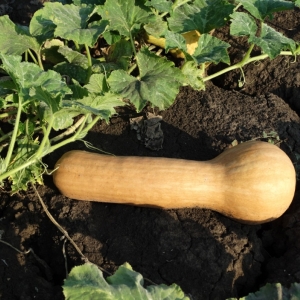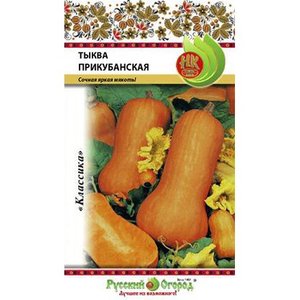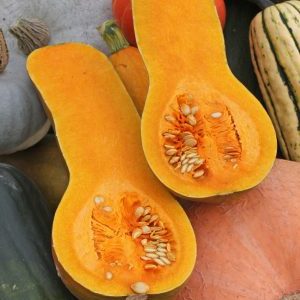A mid-season and unpretentious nutmeg pumpkin variety "Kubanskaya": what is good and how to grow it correctly
Pumpkin is a low-calorie vegetable that is free of saturated fat and cholesterol. At the same time, pumpkin fruits are rich in fiber, antioxidants, vitamins and minerals. The vegetable does not require special care, the main requirement is that the soil should allow the development of a root system of the required length and branching.
The sweetest is traditionally considered to be butternut squash. The birthplace of culture is hot Mexico, for this reason nutmeg varieties they did not immediately take root in Russia, because they need an abundance of sun and a long period of heat for ripening.
However, domestic breeders began to develop varieties that are quite suitable for cultivation in the southern regions of our country.
The content of the article
Description of pumpkin variety
In the Krasnodar Research Institute of Vegetable and Potato Farming, a new variety of nutmeg pumpkin Prikubanskaya, which is commonly called simply Kuban, was bred.
Distinctive features
 The Prikubanskaya pumpkin is characterized by an orange-red color and a sweet taste, and the sweetness and, to a certain extent, a soft texture are preserved even during long-term storage.
The Prikubanskaya pumpkin is characterized by an orange-red color and a sweet taste, and the sweetness and, to a certain extent, a soft texture are preserved even during long-term storage.
Pumpkin whips do not differ in particular length, they are considered medium, and the main stem stretches up to 400 cm.The leaves are in the shape of a pentagon of dark green color interspersed with white spots.
Fruit characteristics and yield
The fruits of this variety are even, in the form of cylinders, thickening in the lower part. Color - orange-brown.
Fruit weight - from 2 to 4.6 kg. Fruits ripen in different weather conditions - from 90 to 135 days.
Most gardeners claim that the fruit of this variety retains its presentation and taste for up to 3 months.
The yield is 1-2 kg per sq. m, depending on the temperature regime of growing.
How to grow
You can grow pumpkin by seed and seedlings. Next, we will consider each of them separately.
Planting with seeds / seedlings
Since this crop has a relatively long ripening period, it is recommended to grow butternut squash in seedlings. It is recommended to plant Prikubanskaya pumpkin on seedlings approximately three weeks before planting in open ground, in most regions this is the end of April.
Planting with seeds
The process of seed preparation is important when growing any kind of nutmeg gourd, since the size and taste of the future harvest will largely depend on the quality of the seed material.
Initially, the seeds are soaked in relatively hot (up to 40 ° C) water, then wrapped in a damp cloth and left at room temperature for several days. This simple procedure will facilitate germination and disinfect the seed.
Further, the moisture resistance of the seeds is increased. To this end, the seeds, all in the same damp cloth, are sent to the lower shelf of the refrigerator for 5 days.
The culture does not tolerate diving and transplanting, so it is recommended to immediately plant the seeds in separate peat pots. Ordinary wooden seedling boxes are fine, only the distance between the seeds should be increased immediately.
The soil is recommended as follows: a mixture of 2 parts of peat and 1 part of sawdust or deciduous humus. You can add a little fertilizer in the form of nitrophosphate.If you buy soil directly from the store, soil for vegetables is most suitable.
The mixture is laid out in pots and watered abundantly. After that, holes are made in it, where the prepared seeds are planted. The depth is about 5 cm.
The pots are immediately exposed on a well-lit windowsill and covered with plastic to create a greenhouse effect.
It is possible to plant in open ground when 3 real leaves appear, but you should not rush, wait until the average air temperature rises to at least +18 ° C. For some time after planting, it is recommended to cover the seedlings with a film - they are susceptible to any temperature fluctuations, especially in the downward direction.
Planting seedlings
The very name of the pumpkin variety (Prikubanskaya or Kubanskaya) speaks of the desired place for its cultivation. The climate on the banks of the Kuban is relatively warm, already in May the temperature rises above 20 ° C. At this time, sowing in open ground is also recommended.
Important! In regions with a temperate climate, pumpkin of this variety can be fully grown only by seedlings or even under film.
Seeds are prepared in the same way as in the case of seedlings, planting is carried out in rows at a distance of 70-100 cm.You can plant 2-3 seeds in one hole, so that later you can cull weak shoots.
The place for planting and disembarking seedlings is chosen sunny. Recommended plots where the following crops were grown last year:
- potatoes (you need to make sure that the soil is not oversaturated with herbicides);
- tomatoes;
- all types of legumes;
- onion;
- cauliflower and white cabbage.
Care
Caring for nutmeg zoned pumpkin is relatively simple, but requires adherence to certain sequential steps.
Watering
Water it with warm water, and quite abundantly: up to 5 liters per plant. Until the ovaries are formed, watered once a week, then once every 2 weeks is enough.
Important! After each watering, be sure to loosen the soil. But they do it shallowly. Initially, the root system is actively developing not only in depth, but also in breadth, deep loosening can greatly harm this process.
Top dressing
Top dressing is done in stages:
- the first - after the formation of the 5th leaflet, nitrophoska is used;
- the second is produced by the mullein and is necessary when the whips begin to form.
While watering, you can add some wood ash to the water.
Weed removal and pinching
Remove weeds especially carefully before the formation of lashes, in the future their harm is minimal.
Important! It is not recommended to move the lashes when weeding, this can lead to falling off or improper formation of the ovaries.
Pinching of the ovaries is performed as needed to form the required number of fruits.
Features of cultivation and possible difficulties
The main enemy of butternut squash is cold. Try to cover fragile sprouts at the first sign of a drop in temperature. Cooling may not destroy the plant, but it will certainly make the ripening of the fruits longer, and the fruits themselves relatively small.
Another important circumstance: if the groundwater at the planting site is high, the long root system of butternut squash can begin to rot from an excess of moisture, and the plant will die for no apparent reason.
Growing tips from experienced gardeners
There are several secrets for growing this pumpkin variety that are good to know:
- The older the seeds, the better. It is optimal if they were stored somewhere for several years.
- Do not water the pumpkin during flowering, this delays pollination, making the pollen heavier.
- If you want to grow a large pumpkin, leave only one fruit per plant.
- It is impossible to pick the pumpkin too early, even if the fruit is already fully formed in appearance, - during storage unripe, unripe pumpkin will start rot.
Diseases and pests
It is believed that pests do not favor pumpkin.But they are still greedy for nutmeg, because it is sweet. There are also a number of diseases that you may have to face:
- Powdery mildew develops in the event of sudden changes in day and night temperatures. The disease can be prevented by covering the plants at night with a film.
- Anthracnose often affects plants that are grown under the film, the leaves and stems turn pink and die off. The reason is high humidity and excessive watering.
- Ascochitis can also occur due to moisture or frost in the soil, black spots appear on the leaves. Covering with film material will prevent illness.
- Melon aphids, which suck out plant juices, will scare off the infusion of wormwood or chamomile.
Of the pests, slugs are especially annoying. They must be collected and destroyed in time; it is advisable to enclose the site with burlap.
Harvesting and application of the crop
You can harvest Prikubanskaya pumpkin at the end of August and throughout September. The fruit should be cut off, leaving a small tail. After bringing the harvest home, let the pumpkin ripen a little, dry for two weeks in the sun, and then store it in a warm place.
Butternut squash is good baked and steamed, as an additive to cereals, especially millet. This is an excellent choleretic agent, recommended for kidney and liver diseases.
Advantages and disadvantages of the variety
The main advantage of the Kuban pumpkin is that the variety is zoned for local climatic conditions, which is why it takes root so well there. This pumpkin has many beneficial properties:
- It is believed that nutmeg varieties are completely cholesterol free.

- Despite the sweet taste, such a pumpkin has a minimum of calories.
- Regular consumption of pumpkin in food normalizes the work of the cardiovascular system.
- The pumpkin is suitable for use in dietary and baby food.
- The fruit has a thin skin.
- The variety does not require constant painstaking care during cultivation; many pests and diseases bypass it.
The disadvantages of the Prikubanskaya pumpkin include the following factors:
- Relatively long ripening periods.
- Susceptibility to temperature extremes.
- Frequent consumption of pumpkin can adversely affect the condition of people suffering from gallstone disease.
Reviews
Muscat pumpkins, and in particular the Kuban variety, have many fans.
Sergey, Volnogorsk: “I confess that my first harvest came out“ lumpy ”: I hurried with planting seedlings, because of the cold weather, growth was disturbed, and as a result, the fruits were small. In the second year I was more prudent, covered the beds with foil, and the culture paid off. "
Anna, Belgorod: “We planted this variety around potatoes and the pumpkins ripened well. Children love mashed potatoes, it turns out sweet. And for the whole family we add this pumpkin to the meat in the manti, it comes out very tasty. "
Read also:
Delicious and extremely unusual variety of "Trombone" butternut pumpkin.
Conclusion
If desired, Prikubanskaya pumpkin can be successfully grown not only in the southern regions of Russia, but also in other regions - for this you need to follow the rules of care, cover and plant in time. The extra hassle will surely pay off with its peculiar sweet taste. And the simplicity of growing this variety will not weigh down during other gardening work.